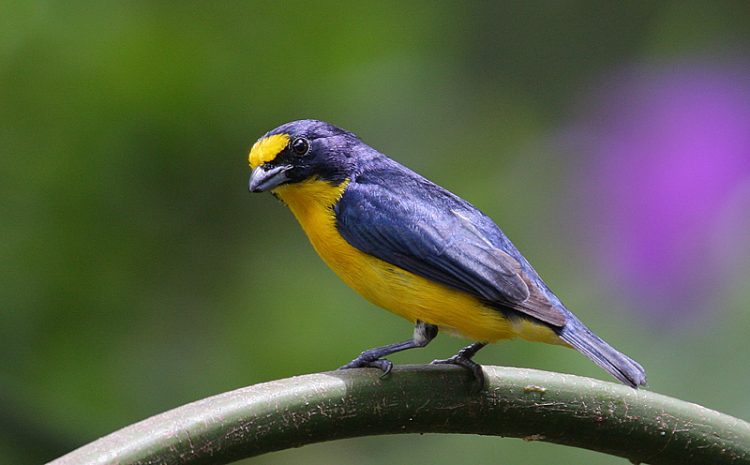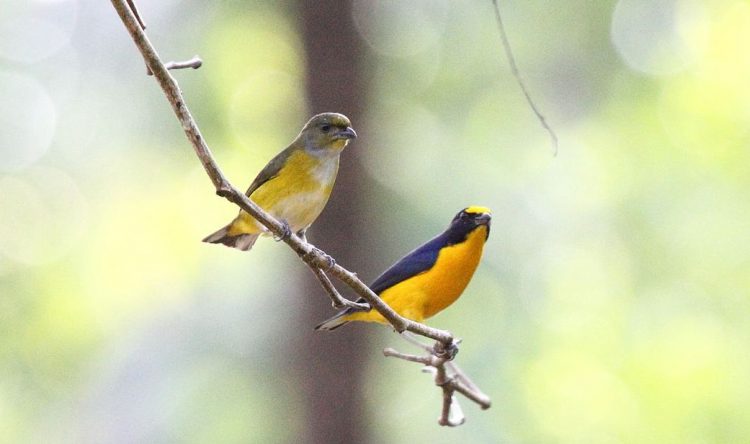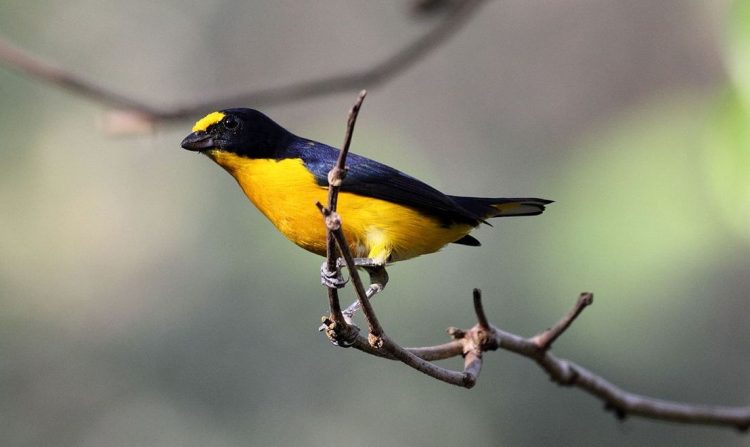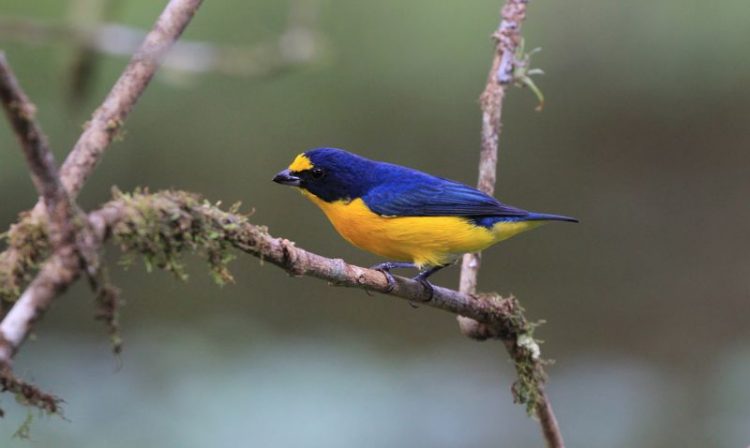The Yellow-throated euphonia ranges from southern Mexico to western Panama, through the lowlands of both coasts and into the highlands to an altitude of possibly 4000 feet above sea level. Like other euphonias, it is a restless bird of the treetops. Except when a nest binds, it rarely appears to remain long in one spot. However, wanders widely in search of food through plantations and pastures with scattered trees and doubtless also over the roof of the forest, where it is difficult to see.
The male is a brilliant little bird, black glossed with violet and blue over all the upper plumage except the forehead and forepart of the crown, which bright yellow like the entire underparts are. The black area includes the sides of the head, the wings, and most of the tail, which is marked with white on the outer rectrices.
From the other black and yellow euphonias that inhabit northern Central America, he is readily distinguished by his yellow rather than black throat and by his notably thicker, black bill. The female is olive-green above, with dull yellow under plumage. These euphonias subsist largely on berries of mistletoe, as do other members of the genus.
 The Yellow-throated euphonia ranges from southern Mexico to western Panama, through the lowlands of both coasts and into the highlands to an altitude of possibly 4000 feet above sea level.
The Yellow-throated euphonia ranges from southern Mexico to western Panama, through the lowlands of both coasts and into the highlands to an altitude of possibly 4000 feet above sea level.VOICE
The only song you will hear from this little tanager is a short whistle, usually repeated two or three times in rapid sequence, sometimes clear and bell-like, more rarely with a plaintive intonation, reminding me of the opening notes of the White-throated Sparrow’s song, but fuller in tone. The female’s song, or perhaps it should be considered a call, at its best, resembles that of the male, but more often it is thin and chaffy in quality and again is high-pitched and almost trilled.
NEST BUILDING
Male Yellow-throated euphonia with a dry grass blade in his bill led to building a nest of the species. The nest was situated in a cranny in the top of a rotting fence post five feet high. It was beside a small corral amid extensive pastures with scattered trees. It was so well shielded behind a small aroid that grew should never have discovered it, had the movements of the building birds not betrayed its position to me.
It was a roofed structure with a little round entrance on the outer side. It was composed of fine tendrils and other bits of vegetation, all bound together with cobweb. The outer shell appeared to have been completed, for the birds were lining the interior with small, dry grass blades.
The male and female worked in the closest harmony. Usually, they arrived together, each with a length of the grass blade in its bill. And one would vanish behind the arrow-shaped leaves of the aroid while the mate perched close by, waiting its turn to place the material in the nest. Either male or female might enter first; there was no set order of precedence.
As soon as the second member of the pair had come out of the nest, the two were off like a flash for more material. Sometimes the male would follow his mate back to the nest without bringing anything. Then while she took her grass blades inside, he lingered close beside the fence post, uttering a fine metallic pink that sounded much like the notes of the Cardinal as he goes to roost on a chill wintry evening, but even fainter.
 The male and female worked in the closest harmony. Usually, they arrived together, each with a length of the grass blade in its bill.
The male and female worked in the closest harmony. Usually, they arrived together, each with a length of the grass blade in its bill.Although this nest was nearly finished when found, the first egg was not laid. Another was deposited on the following day. When I returned to the nest on April 8, there was a male Boat-tailed Grackle resting atop the post where it was hidden. The nest was in ruins and the eggs had vanished.
Although not an actual witness of the grackle’s predation, the circumstantial evidence against him was very strong, especially when it is remembered that grackles, in general, are notorious nest robbers. This nest had been so well concealed that the grackle must have found it; by seeing one of the pair of euphonias enter.
The female euphonia was perching nearby, calling incessantly with a triple, or sometimes double reedy whistles; but her mate did not appear while I waited. Possibly I should have found additional eggs in this nest if the grackle had not destroyed it. A pair of Bonaparte Euphonias building a nest in the axil of the lowest frond of a young coconut palm, 7% feet above the ground.
Again both sexes were bringing material. This nest was never completed. The Bonaparte Euphonias choose a considerable variety of nest sites. In the central plateau of Costa Rica, they have been found nesting in the banks beside streams and roadways, in holes that they most probably found readymade.
A more fortunate nest was situated in the decayed top of a post only forty inches high, in a fence line between a bushy pasture and light second-growth woodland, on the same plantation where the first was found. This nest measured 2% inches from front to back; the doorway was 1% inches in diameter. It had no concealment beyond that afforded by the sides of the cranny in the top of the post.
THE EGGS
When discovered, the nest on the fence post contained three eggs. The female euphonia flew out and was probably then preparing to lay the fourth egg. On the following morning, the set of five eggs was complete. For a tropical bird, this is an unusually large clutch of eggs, and especially so in the tanager family, in which sets of two eggs are the rule and those of more than three are very rare.
The eggs of the Yellow-throated euphoniare short ovate. They are white, heavily blotched with umber in a crown on the thicker end, with a scattering of spots of the same color over the remaining surface. Some have a brownish wash over the entire blunt end, on which the more solid blotches and speckles are laid. Six eggs measured 16.7 by 13.5, 16.7 by 12.3, 16.7 by 12.7, 15.9 by 12.7, and 15.9 by 12.7 and 15.9 by 12.7 millimeters (average of the six, 16.3 by 12.8 millimeters).
 The male is a brilliant little bird, black glossed with violet and blue over all the upper plumage except the forehead and forepart of the crown, which bright yellow like the entire underparts are.
The male is a brilliant little bird, black glossed with violet and blue over all the upper plumage except the forehead and forepart of the crown, which bright yellow like the entire underparts are.INCUBATION
To learn something about the Euphonia's mode of incubation, the day dawned with a dense mist; there was still insufficient light to distinguish the little tanager in the closed nest. A bird flew out, too rapidly to be recognized with certainty, but beyond any reasonable doubt, it was the female. She heard her mate calling in the distance, answered him while sitting, and then flew out and away to join him. The pair returned together and both flew toward the nest, the female a little ahead, but the male following closely.
Each seemed to be trying to reach the doorway before the other. The female won the race and entered; the male turned just short of the doorway and flew off. There was a light flurry of rain. The male, unseen in the distance, called with clear double whistles; the female answered from the nest with similar whistles, but less clear, then left her eggs.
The pair came back together, and with a loud whirr of tiny wings raced each other to the nest. Again the female won by her own length and entered, while the male veered aside just in time to avoid striking the fence post, then continued to some neighboring bushes, where he repeated his double whistles.
Twice more in the morning, the pair of euphonias engage in this race to reach the nest. Each time the female won by the smallest margin. It seemed that this apparent competition was only a formality. The male had no real desire to get there first and sit on the eggs but merely escorted his mate back to her duty in this dashing fashion.
 From the other black and yellow euphonias that inhabit northern Central America.
From the other black and yellow euphonias that inhabit northern Central America.A similar ceremony may be witnessed at nests of the Yellow-crowned Euphonia, the Tawny-bellied Euphonia, the Turquoise-naped Chlorophonia, the Black-crowned Tody-Flycatcher, and the Slate-headed Tody-Flycatcher. All these tiny birds build closed nests with a round doorway in the side. In all both sexes share the work of construction, but only the female incubates, as in the Bonaparte Euphonia.
The female euphonia, upon winning the formal race with her mate, did not appear to alight in the doorway of the nest and then step inside, but on the contrary, passed through the narrow aperture with no apparent break in her movement. She turned around so rapidly that she hardly seemed to have touched the nest before she was seated on her eggs with her head outward.
She always incubated in this position, looking out. For so diminutive a bird, she sat very patiently. Her sessions on the eggs showed a progressive increase in length in the course of the morning, first 32, then 54, 69, and 83 minutes. Her corresponding recesses were 16, 8, 44, and 40 minutes. Her average session was 59.5 minutes, her average recess 27 minutes; and in six hours of the morning, she kept the eggs covered 68.8 percent of the time.
Although the male euphonia appeared to be very attentive, he was nearly always out of sight and hearing while his mate sat in the nest. Whenever I was obliged to force her to leave the eggs so that I might see whether they had hatched, she would perch close by and call incessantly until I departed. While I measured the eggs, an operation that required about twenty minutes because of the difficulty of removing them through the narrow doorway, she continued her calls of distress without interruption during the whole time.
Yet the male never appeared on these occasions; he seemed to forage at a good distance, only approaching the nest when he escorted his mate on her return from a recess, or in the early morning, to call her out to join him. Later in the morning she ended her sessions spontaneously, called to him from near the nest without receiving a reply, then flew off alone to seek him.
That she was successful in establishing contact with him, despite the distance at which he habitually foraged, was clear from the fact that on the two occasions when she left the nest alone, she later returned in his company. It will be recalled that when the Boat-tailed Grackle destroyed the first nest, the female euphonia likewise called for a long while in its vicinity without succeeding in attracting her mate. The set of five eggs had been completed. All five were pipped and had hatched by the following day, thus having an incubation period of sixteen days.
THE NESTLINGS
The young euphonias developed slowly, however when eight days old their black skin was still nearly naked. Their short, thick bills were black with yellow edges, and, when opened, revealed a bright red interior - an attractive combination of colors. Only three nestlings survived.
Time did not permit a study of parental care; but from the fact that the male helped to build the nest, and in view of subsequent observations on related species, there can be little doubt that he took a large share in feeding the nestlings, as appears to be the invariable custom in the tanager family. At the age of fifteen days, the young birds were well feathered and could fly a little.
One afternoon the adjoining pasture was burnt off, and the smoke enveloping the nest became so dense that removed the nestlings for a while to prevent their suffocation. On May 19 the three young euphonias left the nest, at the age of seventeen days. Possibly their departure had been hastened by their premature experience in the open on the day of the fire, for young Yellow-crowned Euphonias stay in the nest until from 22 to 24 days old.
The young male Bonaparte euphonias do not attain the adult plumage in the first year, but begin to breed in transitional plumage, as do the Yellow-crowned Euphonias; the same is true of the Thick-billed euphonias.
SUMMARY
Yellow-throated euphonia wanders widely through clearings and plantations with scattered trees, where they feed largely on the berries of mistletoes. In the Motagua Valley of Guatemala, they nested from March until at least the end of May. Nests were found in the decayed tops of fence posts and in the axil of a coconut palm. In other regions, they have been discovered in holes in banks.
The globular nest with a sideward-facing doorway is built by both sexes, either of which may deposit its material first when they come together. One of the nests in Guatemala contained five eggs, and a set of the same size has been reported from Costa Rica. The female alone incubates. In six mornings hour’s one female took sessions averaging 59.5 minutes and recesses averaging 27 minutes; she covered her eggs 69 percent of the time.
He returns to the nest were the occasion of a spectacular ceremony, in which the male seemed to race her to the doorway; but she always arrived first. Her eggs hatched after 16 days of incubation. This brood left when 17 days old, but possibly their departure was hastened by their temporary removal when fire threatened their nest several days earlier. Read More - The white-throated magpie-jay
 Yellow-throated euphonia wander widely through clearings and plantations with scattered trees, where they feed largely on the berries of mistletoes.
Yellow-throated euphonia wander widely through clearings and plantations with scattered trees, where they feed largely on the berries of mistletoes.










